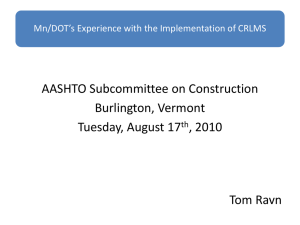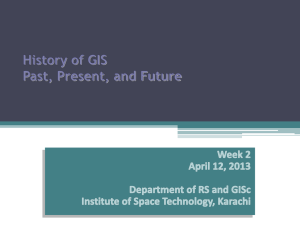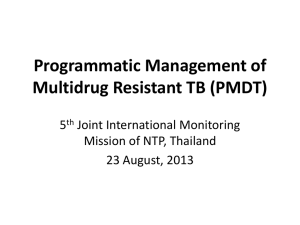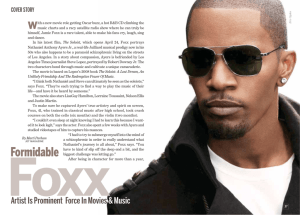Secretary Foxx`s 30YR National Transportation Policy Agenda
advertisement
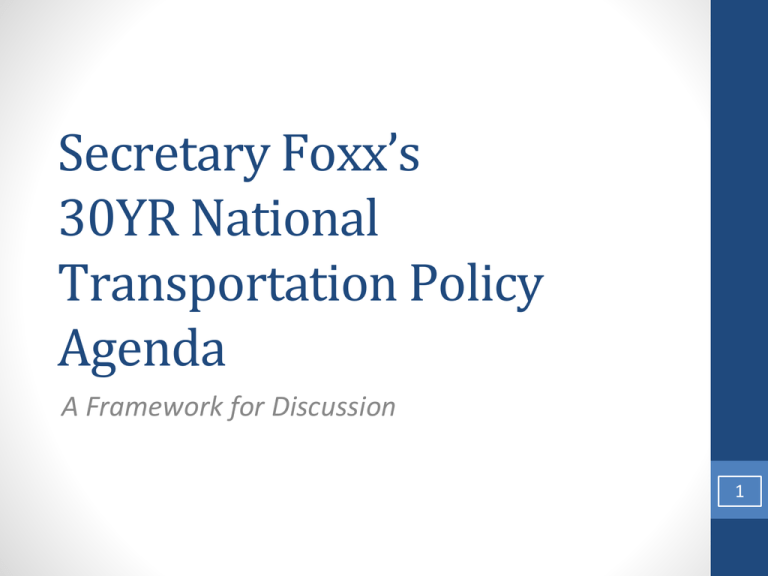
Secretary Foxx’s 30YR National Transportation Policy Agenda A Framework for Discussion 1 30-Year Agenda Process • Introduction/Purpose A look at Transportation from the Users’ point of view, and as an Integrated System; providing an intellectual reset for transportation policy over the next 3 decades, building off 40 years of strategic transportation plans, research, and visions. • Overall Format– Segmented to provide: a) b) c) Global view of the drivers affecting transportation over the recent decades and today; Focused review of the implications of these drivers; and Options for changing our approach to making transportation policy choices; shift to a more multimodal, connected system, designed to provide mobility choice for diverse populations; and elaborating on potential pathways looking forward. • Current work focused on the first two sections above; visioning/scenarios exercise will follow in the next two months. 2 30 Year Agenda Purpose (cont.) • A compilation designed for policymakers to learn from and digest: • Providing Facts • Demographic/Economic Trends Transportation Network • Future Challenges + Policy Options 3 Overview: Where we are • Snapshots of six group outlines covering: • • • • • • Mobility & Capacity Population & Demographic Energy & Environment Technology & Data Finance & Economics Governance • Compiled resources and prior findings • Highlight important findings from Coleman, Skinner, Slater and others • Snapshot of the System Today • Recent Trends Affecting the System • Significant Issues Encountered in Each Area • Key Questions to Drive Visioning 4 Overview: Process Finance & Economics Energy & Environment Components of a National Transportation Agenda Population & Demographic Future Transportation System Performance and Drivers • Reliability • Safety • Climate Change • Mobility Policy Options • Congestion to Enable: • Land Use • Accessibility • Connectivity • Economic Competitiveness • Quality of Life • Environmental Sustainability • Access to Opportunity • National & Personal Security • Resilience Technology & Data Governance Mobility & Capacity 5 Source: 30 Year Vision – Surface Transportation System by: Dr. Michael Myer Foundational Predecessors… • Secretary Foxx has requested a 30-year “plan” based on a factual assessment of recent and current transportation trends and possible futures. He refers to the Department of Transportation’s National Transportation Trends and Choices to the Year 2000, published in January 1977, as a model for his own thinking. While national transportation policy studies go back to the Gallatin Report of 1808, the most recent efforts offer different approaches and emphases that help to inform the current effort. 6 Trends and Choices • Initiated by Secretary Coleman as the successor to congressionally required National Transportation Reports published in 1972 and 1974. • National Transportation Trends and Choices to the Year 2000 encompasses over 400 pages with extensive analysis of a wide range of transportation trends and issues. A large-format supplement includes a comprehensive set of reference and thematic maps. • Produced by approximately 8 staff of the policy office in the Office of the Secretary over 18-24 months, the report built on extensive analytical capabilities developed for OST in the early years of the Department. • Legacy: In many ways, Trends and Choices represented a highpoint of capability within OST, with extensive analysis, creative visualizations, and comprehensive coverage all conceived and executed internally by policy staff. Because the report was released at the end of an administration, Trends and Choices was largely ignored by subsequent DOT leadership, and the internal analytical capabilities of OST atrophied over the next 20 years. The supplemental volume remains the most complete atlas of reference and thematic maps produced by DOT. 7 Anecdotal interlude: Pre-briefing memo for Presidential Meeting: National Transportation: Trends and Choices • National Transportation: Trends and Choices, as its title suggests, seeks to describe the major national trends affecting the transport sector over the next 15-25 years; and to identify the areas where public choices may be necessary to intervene in those trends, to redirect them along paths more responsive to national goals. • The document does not draw conclusions, nor does it make re- commendations. Rather, it highlights the significant decision points facing America, seeks to clarify the issues surrounding those decisions, and portrays the consequences of alternative approaches. • It is comprehensive with respect to all modes of transportation, emphasizing the intermodal relationships to our transport system, and its function of service to the health of the economy and the well being of the people. It treats the transport ramifications of major migration trends, increasing population in our rural areas and small cities, the decline of many of our large cities, including changes in the incomes, composition, and activities of households. In the freight sector it considers the demands of new energy flows, coal and oil ; and expanded agricultural production. In both the freight and passenger sectors the expected levels of 1990 demand are identified and mapped, and the capacity of the expected 1990 transport system to meet those demands is assessed. 8 • It is not a programmatic document. It treats the entire transport sector, not only those parts of it traditionally associated with the Department, e.g., waterways and pipelines. No Federal funding implications are drawn, nor any public-private divisions of responsibility established. • In brief, it seeks to identify what transport system is required to best serve the Nation in 1990, and to clearly present a conception of that system for informal public discussion. Press and public reaction in the ten days since its release have been excellent, and requests for copies from the States, industry, and the general public run high. Appreciation of the document seems to stem from its attempt to see transport decisions in their broadest social and economic context and their long term implications, rather than from any particular treatment of a specific issue. • The document prepared over a period of a year and a half contains extensive information on population and commodity growth, on transport supply and performance, and on extensive series of national and State maps. • A program is sketched out for public review and comment over the next year, culminating in a revised document a year later. Thus, it can serve as a sounding board for gaining reactions on major public questions facing us, and provide valuable insight into national attitudes toward transport needs. A more final document in two years can reflect both response to those views, and our increased analytical capacity to treat these questions. 9 National Transportation Policy Study Commission (NTPSC) • Established by Congress in the 1976 Federal-aid Highway Act for an independent perspective on transportation. • National Transportation Policies through 2000 is approximately 500 pages. The report was based on hearings held around the country, an extensive modeling system developed by contractors for 20-year forecasts, and a number of seminars and working papers on special topics. Much of the focus was on deregulation, the Energy Crisis, and investment needs. The NTPSC staff had very little interaction with DOT, though reports of DOT and the Department of Energy were used as major references. • NTPSC included 19 commissioners (6 Congressmen, 6 Senators, 7 Presidential appointees) and a staff of about 50 mostly drawn from outside Washington. The work was conducted in 1977-1979. • Legacy: the NTPSC recommendations reflected or guided lasting policy in two major areas: deregulation and shifting the Interstate program from completion to reconstruction. The former was expected at the outset, while the latter grew out of the study. The final report was cited for over a decade because it had no successor that dealt comprehensively with a broad range of issues. 10 National Transportation Policy (NTP) • Initiated by Secretary Skinner as a strategic plan for DOT promised during his confirmation hearings. • Moving America: A Statement of National Transportation Policy, published in 1990, is slightly more than 100 pages containing 169 bulleted statements of policy and 65 bulleted proposals. Most discussion of trends is in a separate environmental scan published early in the effort. A summary of public hearings was not published. • The NTP was guided by a Core Group of operating administration heads co-chaired by the Deputy Secretary and the FHWA Administrator, several Cluster Groups drawn from operating administration staff to conduct outreach hearings, and the NTP Team by 11 senior career policy analysts and managers and 3 support staff drawn from throughout DOT. The work was completed in approximately 9 months, including OMB review. • Legacy: Moving America produced a comprehensive compilation of DOT policies. Personal associations established through the intermodal Cluster Groups and NTP Team significantly enhanced staff communications throughout DOT. The bulleted proposals reflected Administration views on legislation then under consideration. The NTP initiated a Transportation Research Board study that led to the creation of the Bureau of Transportation Statistics. The creation of BTS in ISTEA was a specific effort to rebuild in an “independent” entity, the analytic capability which produced both Trends and Choices and the congressionally led NTPSC. 11 Changing Faces of Transportation • Secretary Slater intended these documents to provide an historical perspective for policymaking, by reviewing major policy milestones and their context in the last decade of the 20th Century. The report then poses future policy choices and challenges. • The Changing Face of Transportation, published in 2000, is 360+ pages • The report is a seven-section document, that includes “Visions Past and Future,” “Growth, Deregulation, and Intermodalism,” “Safety,” “Globalization,” “People, Energy, and the Environment,” “Technology,” and “National Security.” • Purpose of the report: • Present a blueprint for a transportation system that improves our total quality of life • Provide a vision for future policymakers for the 21st century • Show that aggressive, “stretch” goals can be achieved through collaborative leadership and partnership • Estimate and illustrate potential results of current policies • Show potential improvements that could come from the Department’s Strategic Goals • Illustrate the current Administration’s infrastructure investments • Forecast and show impacts of policies • Show the emerging trends in transportation demand and their potential impacts • Encourage a collaborative decision-making process that takes into account all stakeholders • Facilitate a transportation system that strongly connects the nation and and the nation to the world 12 Four other notable pieces • TRB Informing Transportation Policy Choices — Celebrating the 20th Anniversary of Conducting Policy Studies (2003) • Long Range Strategic Issues Facing the Transportation Industry, Final Research Plan Framework, NCHRP 20-80 (2008) • Toward a Vision for the Nation’s Surface Transportation System: Policies to Transcend Boundaries and Transition to a New Era, America 2050, Michael Meyer (2008) • TRB Critical Issues in Transportation (2013) 13 Foxx 30YR Agenda Timeline Setting the Framework Building the Structure Filling Gaps Finalize Sections 1 & 2 Visioning for Section 3 NOVEMBER OCTOBER SEPTEMBER AUGUST JULY JUNE MAY APRIL Putting it all Together 14 Question & Comments? 15

